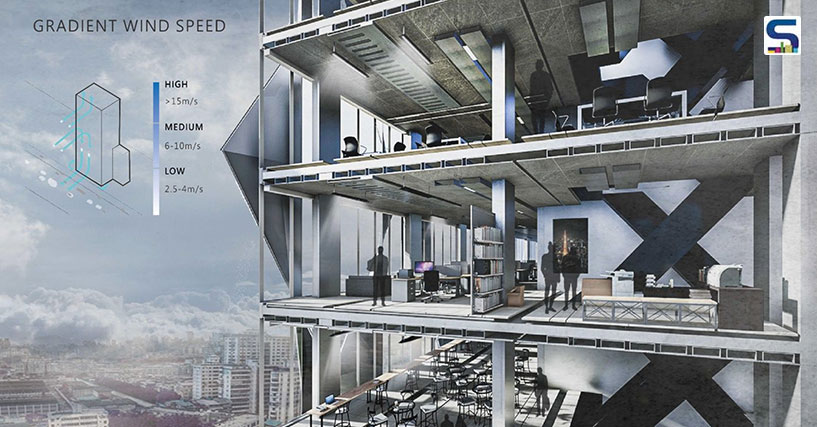
The spatial pressure on cities has been increasing day by day as the world continues to urbanise. Urbanization has led buildings to rise higher and higher. At higher altitudes, buildings are subjected to stronger winds, which further cause greater stress on the structure. National Taiwan University of Science and Technology’s Lang Wen Ma, Yu Xiang Huang and Wei Kai Wu designed the Wind Digester to divert and reduce wind pressure on the surface of tall buildings and to utilize this natural wind energy to generate electricity for indoor use as well. A report by SURFACES REPORTER (SR).
A thorough-thought solution for clean energy, the Wind Digester can be integrated into the structure of buildings. Taller buildings and high rises are exposed to high and strong winds, which can cause structural failure. The design of the Wind Digester turns their altitude into a positive way and also offers cost savings. Additionally, it also adds an interesting and attractive design element to the facade of the building.

How it works
Wind Digester aims at utilizing the vast wind area of buildings for wind power production. Since the wind speed increases with height, stronger winds without diversion can cause skyscrapers to wobble. As a spoiler, the pressure of the surface is reduced and the turbulence is guided by windsail to the generator. On each floor, electricity is provided for electrical devices.
The bionic curved panels mimic the cavity of a shell to enlarge the frequency of turbulence to make a piezo-electric generator produce more electricity. The energy then transits directly to the electricity-consuming system to reduce the long route and the loss of energy.
The covered area of the Wind Digester can be changed through the control system, which responds and adjusts to the physical environment of the building. Through the transformation, the natural light, the air convection humidity and temperature can also be adjusted to reduce the mass consumption of energy.
Situated on the top of the building, the main electrical control room transfers the kinetic energy to electricity. Additionally, there are subsidiary electrical rooms which are located on every four floors and are designed as temporary power storage systems to save energy. Designed to disturb the strong convection from the upper façade, the podium building combines the power of the Wind Digester, thereby offering passersby a comfortable and non-oppressive feeling which is generally caused by strong building wind.
The Wind Digester helps in cooling down and adjusting the luminance to save nearly 20-50 per cent of energy. The advantage of the PVDF includes proper resistance against weathering, dirt, wearing, impact, chemical erosion, ultraviolet rays and radiation while it is flexible and able to keep colour appropriately.
SR View
Moving ahead in the design field in order to create futuristic structures which, instead of guzzling, can generate and store energy is the need of the hour. The concept like Wind Digester are vital to fufill the growing enerrgy needs without depleting the natural resources which are already at the brink of extinction. As the number of skyscrapers are growing in every city, using such elements which not only reduce the building's own electricty bills but also generate more energy, can be a game changer. SURFACES REPORTER (SR), in its quest to bring out the latest developments in the architecture and design field, supports such developments and hope that very soon, clean and green energy becomes the most crucial way of living.
Image credits: Green Product Award